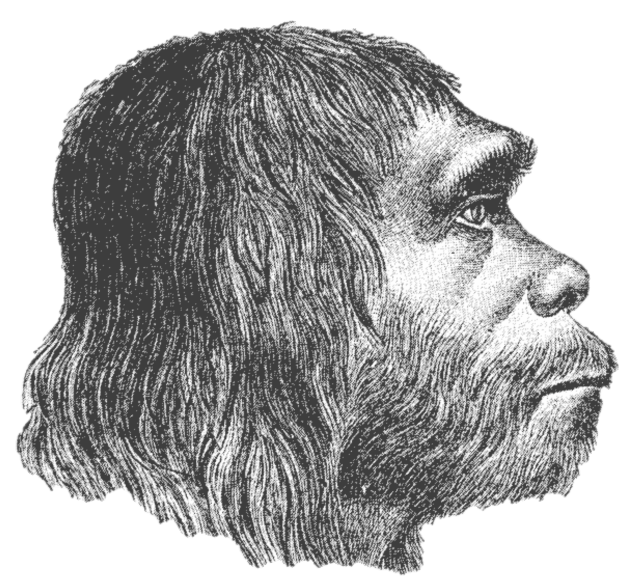Early man lived in this country from the oldest stages of the stone age. His pre-sence attested by the discovery of numerous deposits of stone implements and other remains in caves and rock-shelters on the northern and eastern mountains or on plateau to the east and the desert to the west. In the Old Stone Age (Paleolithic Period) man made his tools and weapons out of stone. Archaeologists have divided this mind into different sub-periods named after sites at which they were identified. mostly in France and the Alps, North Africa and the Far and Near East stone Age man, a food-gathering savage, wandered over the plains and forests to collect his food, and used stones as implements in hunting. He used hand-axes for self-defense and to overcome his prey and later out of flint flakes he made knives and scrapers rubbed his stone implements into better shapes. He used bones and wood knives and in later periods. There are hundreds of works dealing with the stone and prehistoric ages in general, as well as works confined to Iraq, the subject-matter of this particular work The terminology and definitions below are used by prehistorians to chart the development of Prehistoric Ages in Iraq
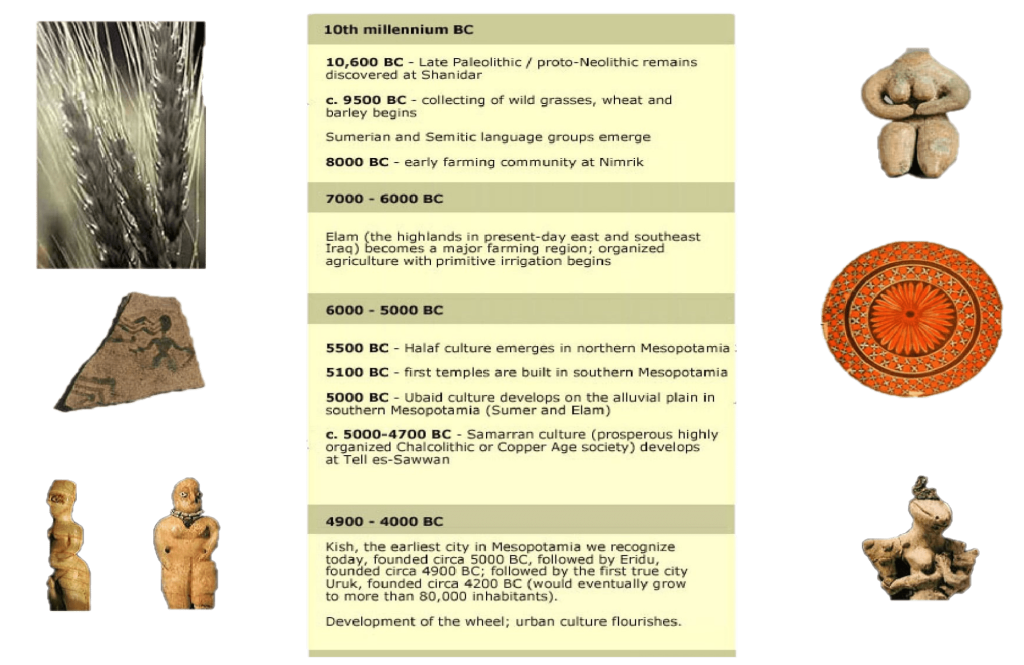
Palaeolithic Period
Among the most ancient sites that yielded specimens of stone implements belonging to this period in Iraq is Barda Balka, three kilometres north-east of Chemchemal in Kirkuk Governorate”. The finds made at this site include large numbers of stone implements of various types, such as coup-de-poing axes, pebble tools and small flakes, identified with the Acheulian Epoch, Lower Palaeolithic Period, and datable to over 100,000 years ago.
The archaeological specimens from Hazar Merd cave (C) in Sulaymaniyah Governorate and Shanidar cave (D) in Erbil Governorate are mainly Mousterian type artifacts and are datable to over 40,000 years ago
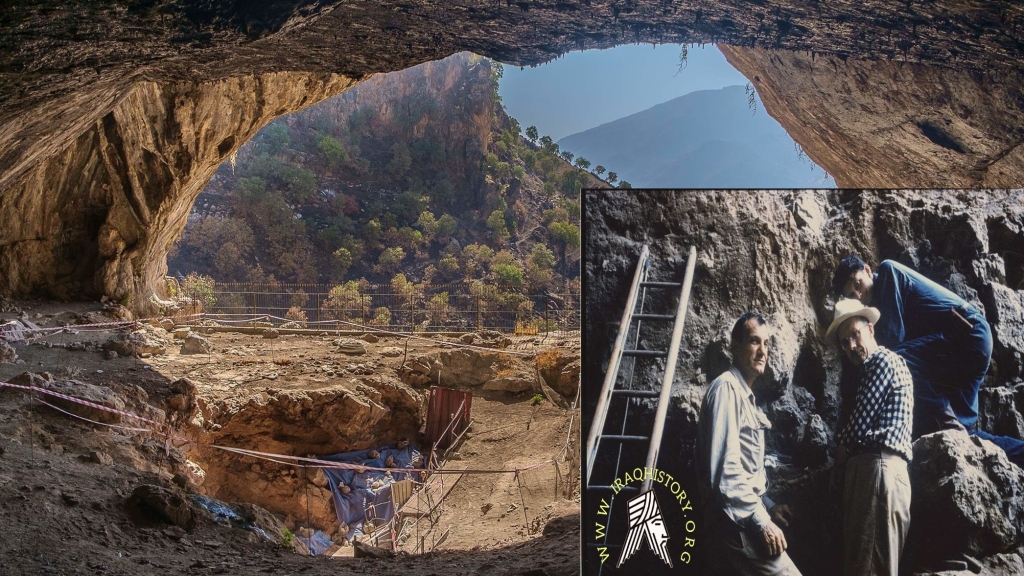
Shanidar cave in 1960, with Ralph Solecki on the right
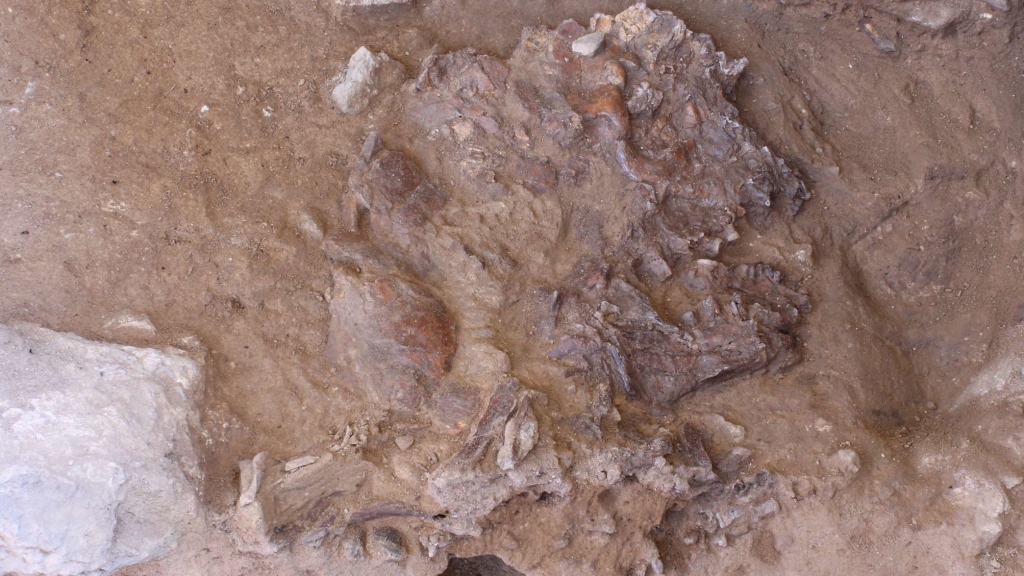
The Neanderthal skull, flattened by thousands of years in Shanidar Cave
The Mousterian layer of Shanidar Cave produced a Neanderthal skeleton This significant discovery of a skeleton of Homo Neanderthalensis, who antedates Homo sapiens, ranks the Shanidar cave among the more important Palaeo-anthropological sites in the world
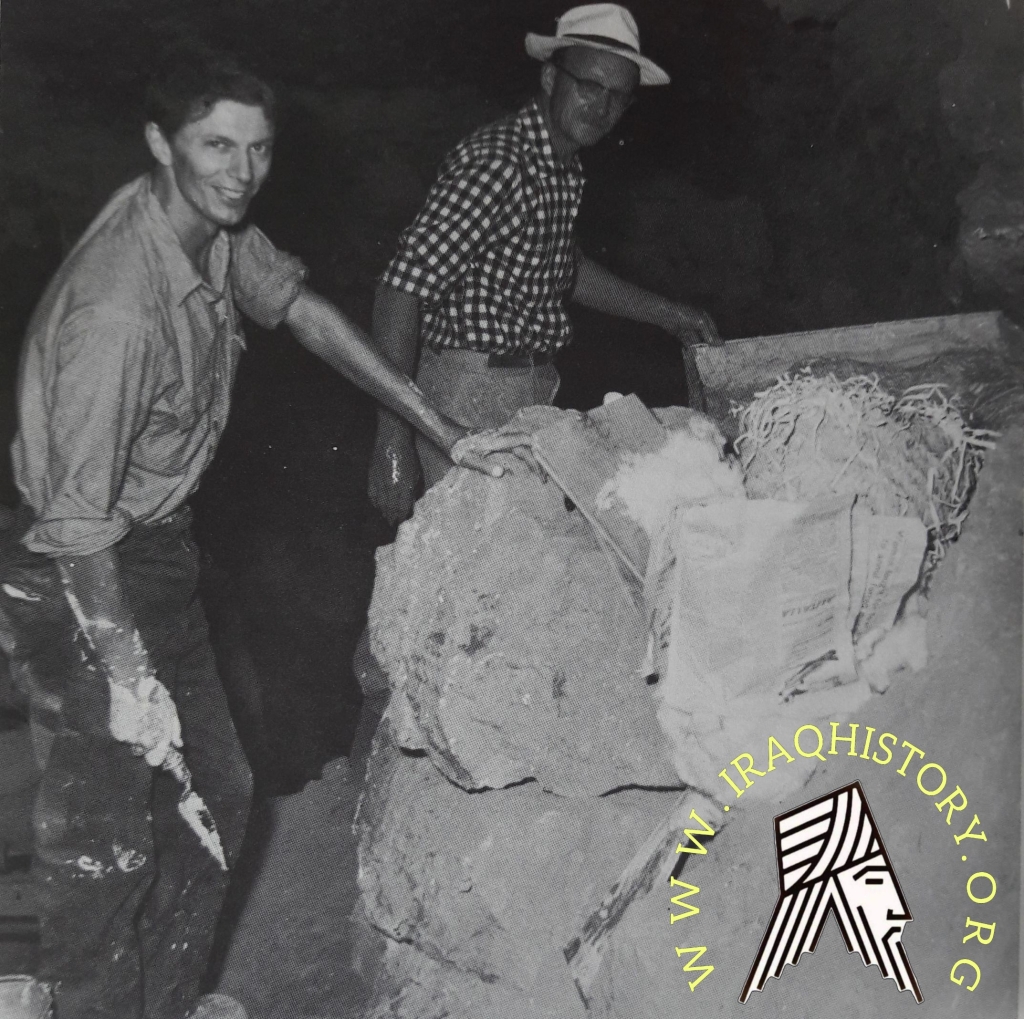
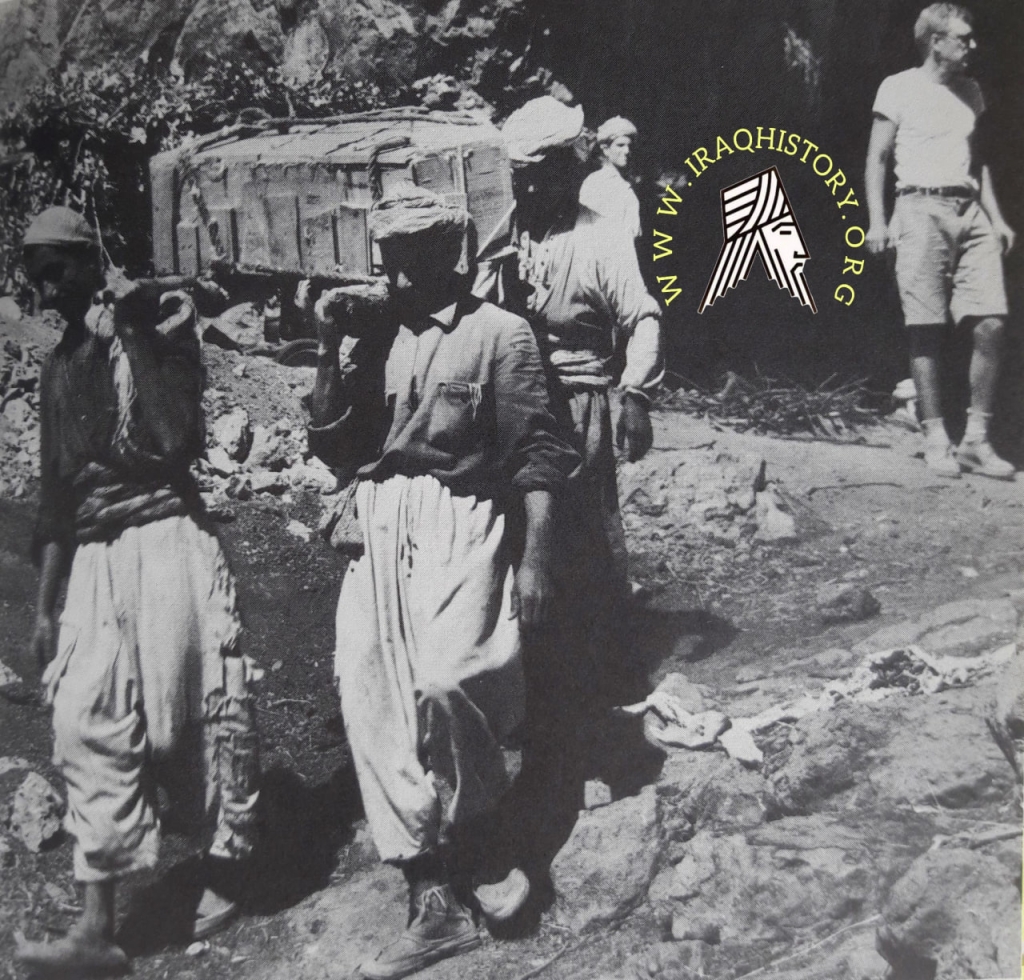
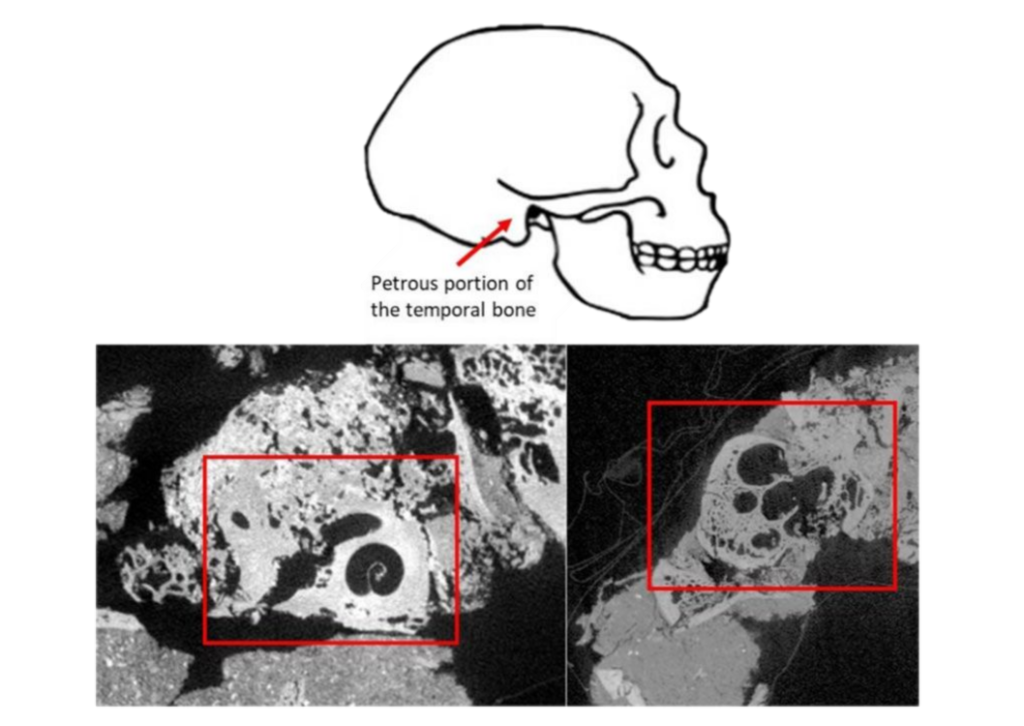
Cross-sectional CT image showing the petrous part of the temporal and inner ear of the new Shanidar skull

———————————————————————————————–
Mesolithic Period
Plentiful Mesolithic deposits occurred in a number of ancient sites in the North including Karim Shahir in Kirkuk Governorate. Mullafa’at on the Khazer river in Nineveh Governorate, Gird Chai, a mound which is in full view of the Upper Zab river, and Zawa Chami not far from Shanidar Cave The material assemblage from these sites is datable to over 10,000 years ago
———————————————————————————————–
Neolithic Period
The Neolithic revolution took place by progressive steps some time close to 10 0no.years ago when the first stages of plant husbandry started. Man’s learning to till the land and cultivate plants was one of the important factors of his development, making it necessary for him to settle close by his fields, and leading to the construction of the first huts made of mud tauf (adobe) and mats, and the growth of villages. Man gradually learnt to produce his own food by the cultivation of plants and the domestication of animals, and to develop his social tendencies and creeds. This period is divided into two epochs.
Lower Neolithic
Artifactual material from this epoch occurred in some of the lower levels of Jarmo, Gird Chai and several other sites According to date estimate by C-14 Analysis and to comparative studies with other material, the assemblage appears to approach 6750 B.C. This epoch furnished groupings of more developed stone implements such as celts fitted to wooden hafts, hoes, flake-scrapers; obsidian sickle blades are present throughout. There are examples of spoons, commonly in bone, a variety of tools for odd purposes, bone pin sand needles, pendants, nails and objects classified as bracelets. Also, common items are figurines representing animals and the Mother Goddess, the deity of fecundity and procreation. Man, also used bows and arrows.
Upper Neolithic
Great quantities of material pertaining to this period occurred in the upper levels of Jarmo and the lower levels of Tell Hassuna, Samarra, Halaf, Obaid, Warka and Jamdat Nasr. The distinctive feature of this period apart from agriculture and the beginning of sedentary life is the appearance of pottery. The pottery, later developed into varying types of painted ware. Neolithic and pre-dynastic periods In view of the long span of time of the range from the eighth millennium to the end of the fourth millennium B.C. their considerable archaeological assemblages, archaeologists have divided those centuries into certain main periods, each of them characterized by a distinctive cultural as-assemblage and named after the site where this assemblage was first identified. (For further reading on these periods the works listed in the Bibliography” are recommended) Archaeologists have arranged these periods in the following chronological order:
1- Jarmo Period :
he village site of Jarmo lies above a ridge near Chemchemal in Kirkuk Governorate where an expedition of the Oriental Institute of the University of Chicago began work in 1948. This Neolithic site is one of the oldest villages identified in Iraq . The houses of Jarmo were built of mud walls ( tauf ) often on rough field-stone foundation and with ceilings made of mats. The people of Jarmo, mainly living by the domestication animals and, on a small scale, the cultivation of land, had as well, their own primitive beliefs like the worship of the Mother Goddess the deity of fecundity and procreation The Jarmo assemblage is rich in flint tools and microliths, bone objects such as beads pins and needles and clay figurines and is datable to about 6200/6000 B.C. The uppermost floors yielded large quantities of coarse potsherds.
2 – Es-Sawwan Period :
The site of Tell es-Sawwan is situated on the eastern bank on the Tigris some 10kilometres to the south of the famous spiral minaret of Samarra. The Iraq Directorate General of Antiquities have carried out eight seasons of excavations beginning in 1964 in which spectacular success was achieved by the complete and methodical unearthing f an extensive neolithic settlement datable to the beginning of the 6th millennium B.C. This tell (mound) is at the limits of the gypsum upland to the north and the alluvial plain to the south. Among the remarkable finds made at this site are vessels in creamy alabaster of many shapes and sizes and a fine series of mother-goddess statuettes, mainly found in graves under the lowest stratum. The two lowest and earliest levels furnished coarse pottery of types resembling Hassuna pottery, as well as groups of artifacts and implements datable to this period and a little earlier. The other three levels above contained considerable quantities of painted pottery of the standard Samarra ware. Polychrome Halaf potsherds were also present on the surface upper levels of the mound.
Research work is being carried out to define Tell es-Sawwan’s sequence span in relation to the Hassuna period, its beginning and its termination. Alabaster vessels discovered in graves lying on virgin soil were perhaps buried at a time corresponding fairly closely to the Hassuna period.
3 – Hassuna Period :
The village of Hassuna lies 15 kilometers from the right bank of the Tigris and 35kilometres due south of Mosul. The Iraq Directorate General of Antiquities carried out excavations at this site in 1943 and 1944 and discovered that it is a neolithic village datable to about 5100 B.C. Several occupation levels were exposed. These level supplied large quantities of objects of flint and obsidian, including sickle blades, and symbolic clay figurines. Most significant among the Hassuna finds are its indigenous pottery which has been divided into four types burnished incised-and-painted, mainly orange color with geometrical designs, and course ware At Mattarah near Kirkuk, large quantities of artifacts and objects were found resembling the Hassuna Assemblage
4-Samarra period :
Samarra lies on the Tigris River some 120 kilometers to the north of Baghdad. The German expedition in 1912, digging under houses of the Abbasid period, brought to light large quantities of archaeological material including a local style of pottery later classified as “Samarra Ware This ware, decorated with regular designs, cross-hatched triangles and parallel lines in purplish-colored paint, is datable to circa 5000 B.C. Samarra ware appears in other places such as Tell es-Sawwan in Tell Hassuna and Telul eth-Thalathat
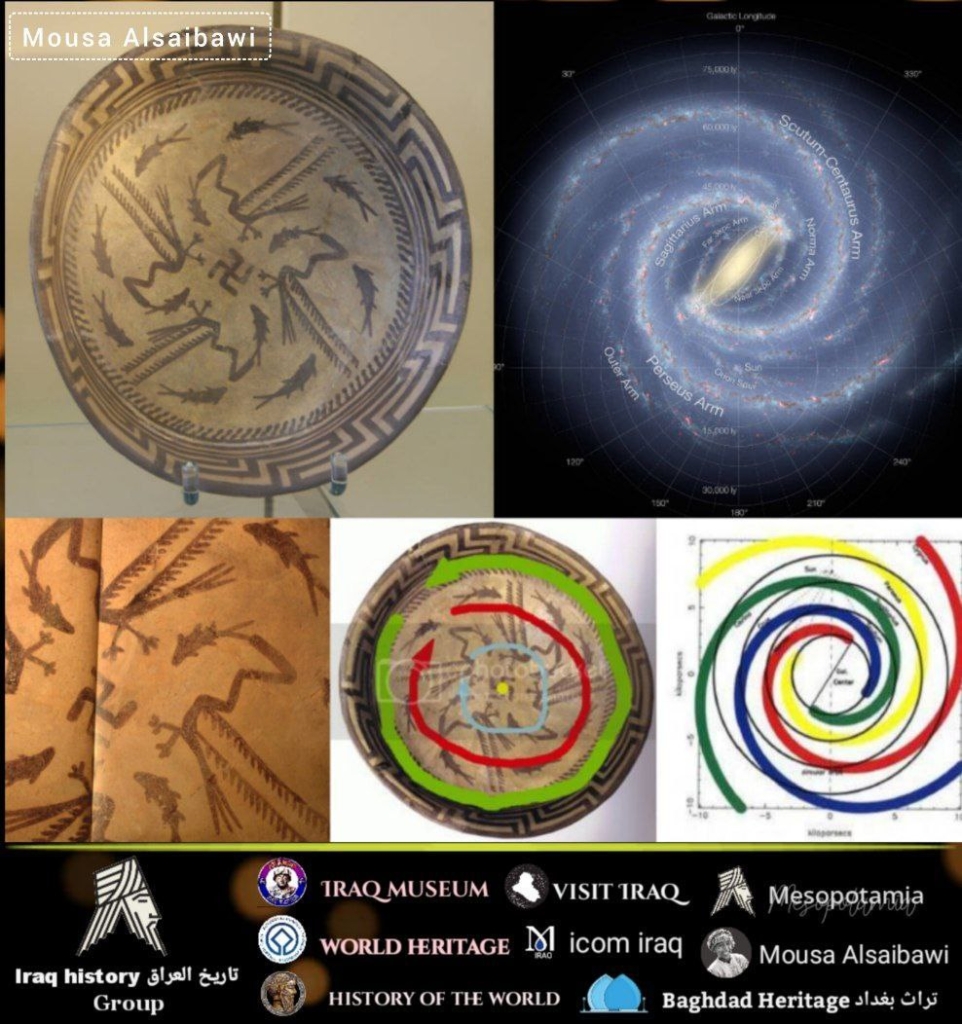
Samarra bowl
The bowl was excavated as Samarra by Ernst Herzfeld in the 1911-1914 campaign and described in a 1930 publication. The design consists of a rim, a circle of eight fish, and four fish swimming towards the center being caught by four birds. As is typical of cultures from this region, the use of a base six numerical system can be seen in the lines surrounding the bowl, so that there are a total of 120 lines, or four quarters with 30 lines each. At the center is a swastika symbol.
On the left is a representation of the Milky Way galaxy, and the position of the sun can be seen, as it is taken here as the center of the angular division, like the swastika in the bowl of Samarra. The movement and directions of the drawings in the bowl of Samarra are very similar to the apparent movements of our Milky Way galaxy, since the swastika associated with the concept of the square wave appears like the center of the galaxy, which the sun rotates. Around him are the spheres Therefore, the Samarra Plate dating back to 5000 BC may be a model of the Milky Way and our solar system
———————————————————————————————–
Chalcolithic Period
About the beginning of the 5th millennium B.C. metals were more known and metallurgy invented. Hammered tools came into use side by side with flint or ground stone tools. Recent excavations at Tell es-Sawwan in Iraq and Chatal Huyuk in Turkey
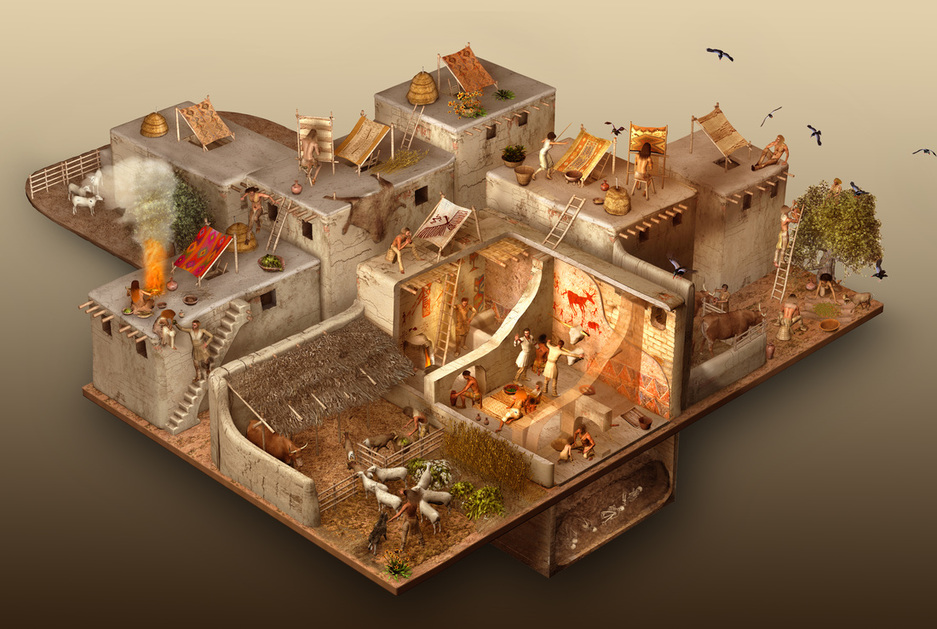
have confirmed that copper was known from the beginning of the 6th millennium B.C. The sub-periods of this sequence are :
1 – Halaf Period :
Tell Halaf (ancient Guzana) is5 kilometers to the south-west of the village of Ras-el-‘Ain in Northern Syria. There large mound overlooking the Khabur River, houta German expedition sent out by the Berlin Museum conducted excavations in 19111913 and 1929 and came upon a thick layer of beautiful o polychrome pottery with minutely executed decoration. This pottery which is usually painted in vivid, lustrous colors and geometrical designs, is datable to circa 4900-4300 B.C. The site yielded many other objects and artifacts. During the following years, however, the excavations conducted at Arpachiya by the British Expedition (specifically in 1933 and 1934 supplied abundant artifactual material and sophisticated types of pottery with similar material occurring at Tepe Gawra near Mosul, excavated by an American Expedition A distinctive feature of this period and the subsequent periods was the advance of various crafts and industries. Man, then began to build up a mature civilization which rapidly progressed over the preceding cultures of the north and north-eastern upland, towards the southern part of the Tigris-Euphrates valley where continued recession of the gulf and the consequent drying-out of the surrounding country left large areas of fertile lands. On this fertile plain, large settlements had emerged to constitute important cultural centres and later prosperous Sumerian cities.
2- Eridu-Hajji Muhammad Period :
Eridu, modern ‘Abu Shahrain, is in the extreme south of Iraq, about 40 kilometres south of Nasiriyah. In 1946-1948 the Iraq Directorate General of Antiquities unearthed just under the Ziggurat an impressive series of 18 temple strata. These temples are dedicated to “Enki”, the god of subterranean waters, later known as ‘Ea’. Expert Studes of the pottery yielded by the lower Levels 14-18 defined Eridu ware as a fine monochrome, usually dark, brown-colored painted ware, decorated with rectilinear patterns such as grids, or small triangles between horizontal lines. These distinctive features confirm for the first time the existence in southern Iraq of an uninterrupted sequencer datable to the second half of the 5th millennium B.C. Another important discovery Madelin this ancient town was a cemetery. In the graves, groups of vessels associated with the Ubaid period were found. A large quantity of pottery which could have developed from Eridu Culture was found Warka, and similar examples occurred at Ras al-Amya near Kish in the Hillah district the site of Hajji Muhammad
3 – Al-Ubaid Period :
Tell al-Ubaid is a mound in southern Iraq, only 6 kilometers to the west of Ur. The British Expedition working at Ur and Abu Shahrain in 1919 incidentally discovered Tell al-Ubaid. The excavators found scattered on the mounds surface a large quantity of fragments of pottery, some of which was vitrified. The pottery of this period dates to circa 4000-3500 B.C. and is often made with the help of the potter’s wheel, bearing the distinctive characteristics of it. Its solidity was due to frequent over-firing, and it has dark paint in thick wavy lines, and animal and floral patterns. (Cases 20-22). The Ubaid Period is a long, cultural stage with remains represented in various sites.
in south and north. The period may, therefore, be divided into two phases: southern. Which is the earlier with relevant examples found in abundance at Eridu, Hajji Muhammad, in the neighborhood of Uruk, Ras el-Amya, Ur, Uruk, Uqair and several other sites. Material of the second, northern phase occurred in sites in the north such Telul eth-Thalathat near Sinjar, where a Japanese Expedition conducted four seasons of excavations (1956-1966) and Tepe Gawra, excavated by an American Expedition. Al-Ubaid ware of this second phase also occurred in many southern sites, such as Al-Ubaid itself, Ur, Eridu, Warka and others.
Archaeological evidence suggests that the beginnings of metallurgy advanced in this period. Copper was hammered cold at first, then later was heated and for the first-time fishhooks, pins, knives and weapons were cast. Also in the Ubaid tradition are the temples and shrines among which the most outstanding are the Eridu temples ouilt on regular advanced architectural plans. Among the typical material of this age are clay sickles, axes, knives, weights (Hall II Case 25) and figurines, some representing the “Mother-Goddess
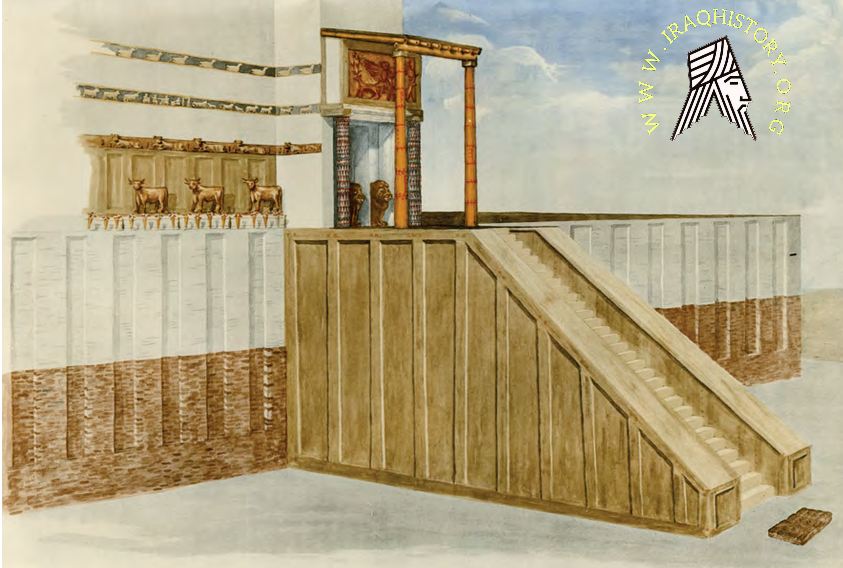
Tell al Ubaid, Temple of Ninhursag. Early Dynastic period (ca. 2600 B.C.E.) (Hall and Woolley 1927)
4- Uruk Period :
The ruins of Uruk (Modern Warka) rise some 30 kilometers south-east of Samawa.The German archaeologists who have been digging at Warka since 1929 (so far 32seasons of excavations) unearthed several historical strata and the remains of prehistoric stratification, namely of the Ubaid, Uruk and Jamdat Nasr periods. The Uruk period estimated to date back to 3500-3100 B.C.. Especially characteristic of the early Uruk period is its pottery which falls into four categories: Red-slipped and burnished, Grey slipped and burnished, coarse ware, and greyish buff pottery in special shapes (Hall II, Case 27). The second or late phase of the Uruk period witnessed vast development in the religious, social and economic spheres and towards the end of this period. (circa 3200 B.C.) writing appeared for the first time in the form of drawings (pictogrsphic) to record revenues for temples and other institutions. Another innovation of thisperiod is sculpture, the earliest sculpture known, applied to large variety of objeetsand a remarkable proficiency is attained in making and engraving cylinder seals Theperiodmention. The façades of temples are covered with coloured patterns composed of conealso marked by an accomplished architecture and by certain forms or ornamosaics, typical examples of which are the “E-ana” temples at Warka.
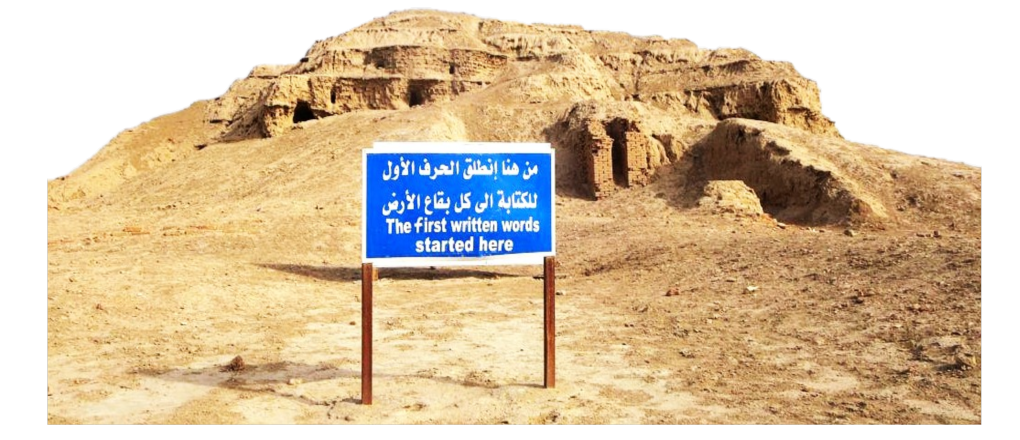
5- Proto-Literate Period :
Archaeologists have used this term to designate the period from the second half of Uruk to the beginning of the Jamdat Nasr periods. This cultural period, for which the invention of writing was a dividing line, has yielded fine relics and artifactual material. The brilliant achievement in design and decoration is typical of the drastic development of this period, particularly in circa 3200-3000 B.C. Progress in the techniques of anand writing are symptoms of a mature civilization. Among the representative collections of this period, mostly from Uruk, exhibited in the Iraq Museum’s Hall III, are, a stele showing hunts-men spearing and shooting lions, the famous votive vase, a life-size white marble bead of a woman in natural size, an alabaster statuette of a naked woman, the upper part of statuette of a bearded man, and a magnificent collection of cylinder seals.
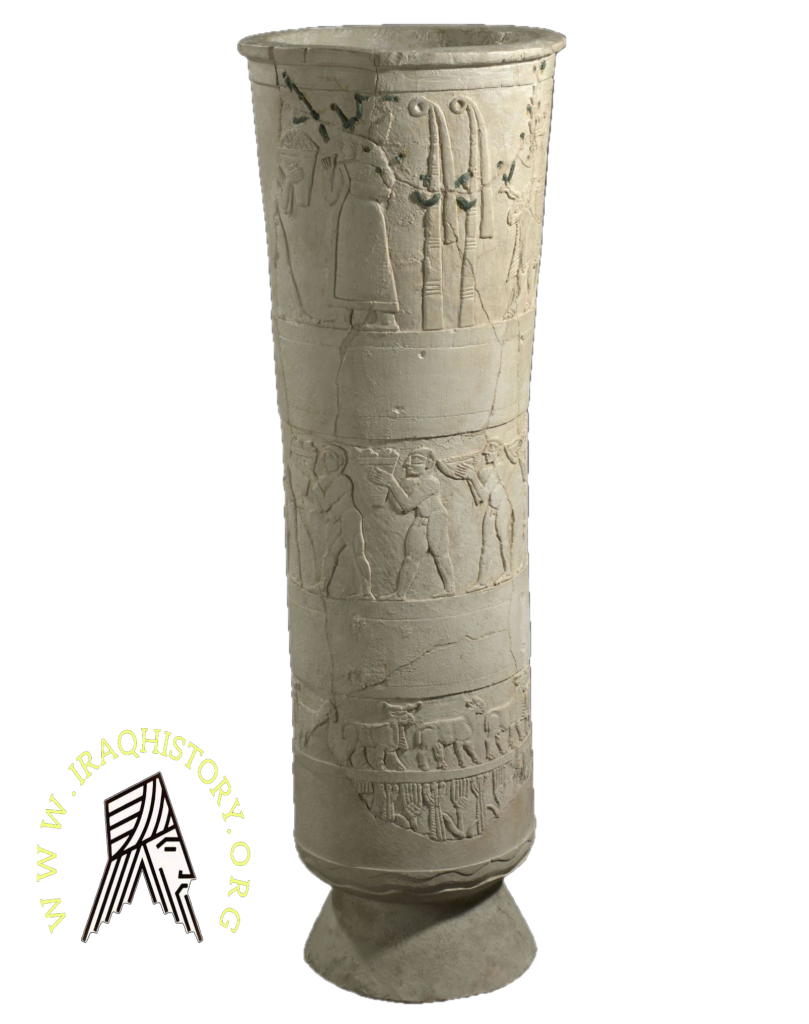
Warka Vase
Carved alabaster vessel found in the ruins of the Eanna, the temple complex of the goddess Inanna in the city of Uruk.iraq The vase is decorated in four registers showing, from bottom to top, vegetation, a procession of animals and nude males carrying bowls and jars, and lastly a full presentation scene before the temple of Inanna. Uruk Period (ca. 3,000 BCE)
6- Jamdat Nasr Period :
The mound of Jamdat Nasr, some 24 kilometers to the north-east of Kish, was first excavated in 1928 by an Anglo-American Expedition and they unearthed a distinctive type of pottery consisting mainly of large thick jars of flattened shapes and naturalistic polychrome designs mostly in red paint, which has been taken as the hall-mark of a cultural period. The Jamdat Nasr Period, which may be defined from circa 3100 2900 B.C.. (Hall II Case 28), also furnished fine artifactual material at Tell al-Uqair, excavated by the Iraqi Directorate General of Antiquities. Among the distinctive features of this cultural stage is the development of the art of writing from small, simplified drawings or pictograms into signs with phonetic values, or phonograms, to keep pace with the urban life under this period. Substantial technical and economic progress was achieved, and stamp seals gained more popularity. Stone vases, bowls and troughs were carved with representations of animals or inlaid with shells. Metallurgy made big strides and improved types of weapons and tools were produced. In the construction of buildings more developed architectural techniques were applied and the temple plans expanded further, with cone mosaic decorations applied to the façade. During this period, a mixture of populations inhabited south Mesopotamia, mainly Sumerian and Semites, but the Sumerians were the dominant race among the ethnic groups that lived in that region, their language and tradition predominated both in urban centres and in the countryside, and soon they founded the big cities of the south, sovereign city states that played an important role in the history Mesopotamia, to be detailed in the following chapters. For further reading on the excavations carried out in many ancient sites of Iraq in the north and south, the works listed in the Bibliography are recommended.
Sources :
Faraj Basmachi + Harvard University + British Museum + Iraq Museum + Louvre Museum + University of Chicago
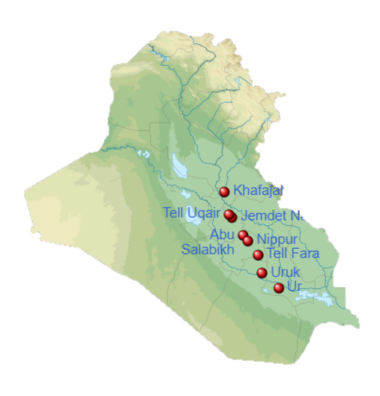
Map of Iraq showing important sites that were occupied during the Jemdet Nasr period
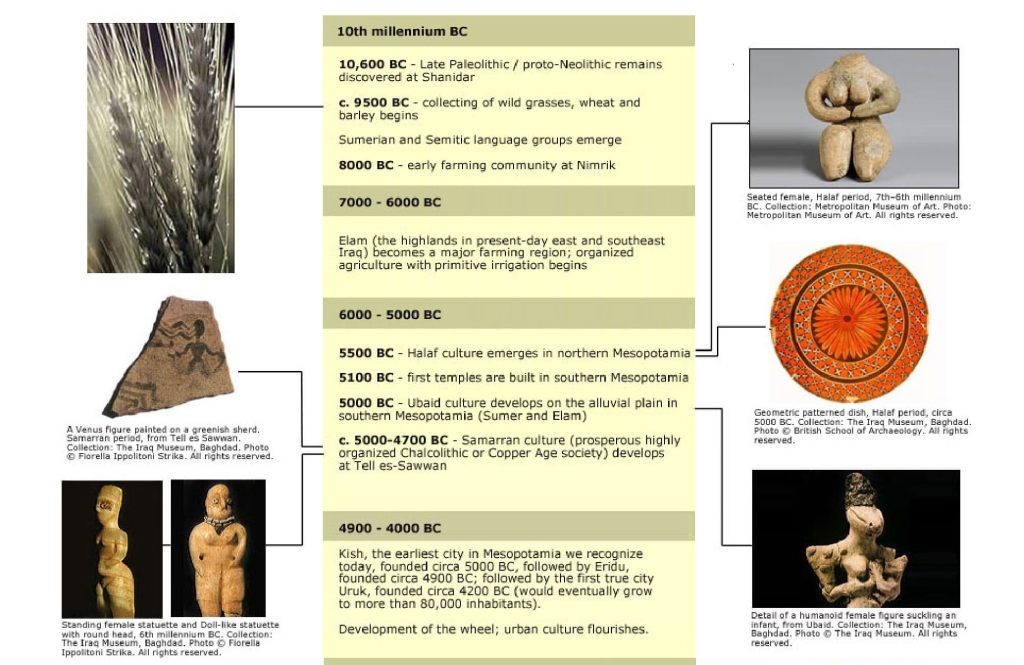
Sources :
Faraj Basmachi + Harvard University + British Museum + Iraq Museum + Louvre Museum + University of Chicago


